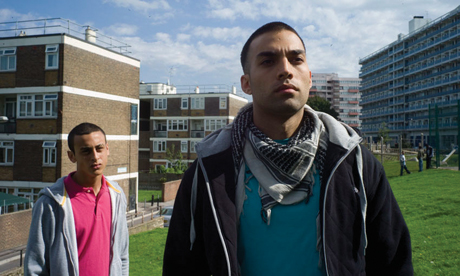My Brother the Devil – review

Made in Hackney: My Brother The Devil
Among the contenders at this year’s London Film Festival, one film was of special interest to Hackney residents. My Brother The Devil, by Egyptian-Welsh director Sally El Hosaini, follows the fortunes of Egyptian brothers Rashid (James Floyd) and Mo (Fady Elsayed), who live with their traditional parents in a cramped flat in an all-too-real Hackney council estate.
The impressionable fourteen-year-old Mo idolises his older brother Rashid, with his street-cred dabblings in boxing, local gangs, drugs and women. When Rashid’s friend is killed by a rival gang, Rashid looks set to exact bloody revenge.
It’s at this point, though, that the film suddenly changes trajectory, with Rashid at the crucial moment instead turning in a radically different direction, jettisoning his association with his gang (who go by the name of DMG – Drugs, Money, Guns) just as Mo seeks to join them.
The film’s gritty social realism echoes Mathieu Kassovitz’s 1995 masterpiece La Haine, set in an equally gritty urban housing project in one of the banlieues of suburban Paris.
Indeed, Saïd Taghmaoui, who played his Maghrebi namesake in that film, appears here (again with his character name the same as his real one) as a Parisian of Arab origin transplanted to London, where he has made a name for himself with his upmarket photography studio.
His appearance in Rashid and Mo’s life changes the dynamic of the story substantially, and it is this, together with Rashid’s turn away from his former life, that leads to Mo’s confusion and existential crisis.
Yet the film shares little of the visually dazzling camera sorcery that marked Kassovitz’s film, with the exception of a stunning scene where Elsayed is captured in hallucinatory sunlight from above while writing rap lyrics sitting on a tree branch.
Instead, the film accentuates the bleak mise-en-scène of the surrounding estate, particularly the sheer claustrophobia of the family’s flat and the squalor of the gang’s abode, where we see them snorting drugs and planning their next move in accurately-worded street slang.
Meanwhile, with the two brothers sharing the same bedroom, El Hosaini captures the sheer lack of privacy and cramped confines of their lodgings. One brilliantly shot scene shows the brothers on their bunkbeds at night, one above the other, with the camera hanging above both as Mo listens to his brother in the bed below having sex with his girlfriend. The couple then have a post-coital whispered discussion which Mo listens in to, whilst pretending to be asleep.
As an addendum, Floyd, Elsayed, and Aymen Hamdouchi (who plays the leader of the DMG gang) appeared after the screening of the film at the Hackney Picturehouse for a short Q&A (El Hosaini has been unable to make most post-film appearances due to illness).
Floyd in particular provided a deft analysis of the main characters, pointing out that under their macho blunderings, “These guys are scared. In the current economic climate, they don’t know if they’re going to get a job or not.”
Indeed, towering over the film is the central performance by Floyd, who captures magnificently the nuances of Rashid’s character, increasingly torn and twisted in different directions by the people around him. After this performance, it should be no big surprise if Floyd hits the big time.
